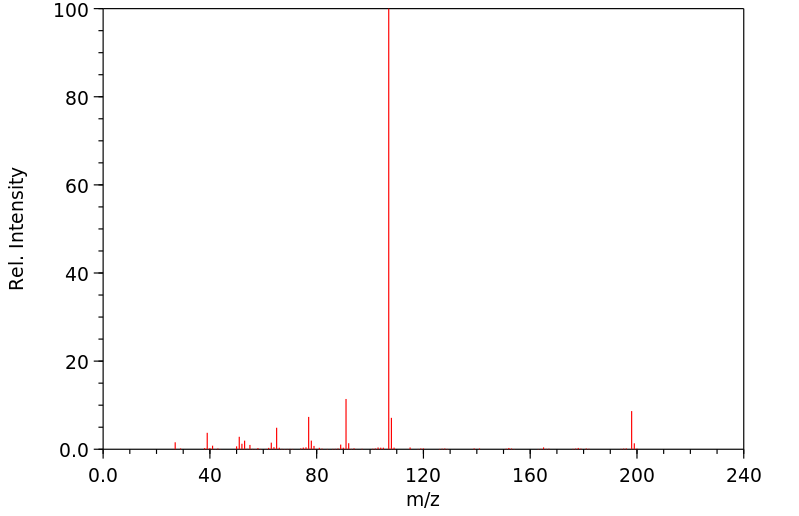4-苯乙基苯酚 | 6335-83-7
中文名称
4-苯乙基苯酚
中文别名
4-(2-苯基乙基)苯酚
英文名称
4-(2-phenylethyl)phenol
英文别名
4-phenethylphenol;4-hydroxydibenzyl;1-phenyl-2-p-hydroxyphenylethane;4-Phenylethylphenol
CAS
6335-83-7
化学式
C14H14O
mdl
——
分子量
198.265
InChiKey
YTLSTADDHMJUMW-UHFFFAOYSA-N
BEILSTEIN
——
EINECS
——
-
物化性质
-
计算性质
-
ADMET
-
安全信息
-
SDS
-
制备方法与用途
-
上下游信息
-
文献信息
-
表征谱图
-
同类化合物
-
相关功能分类
-
相关结构分类
物化性质
-
稳定性/保质期:
存在于主流烟气中。
计算性质
-
辛醇/水分配系数(LogP):4.4
-
重原子数:15
-
可旋转键数:3
-
环数:2.0
-
sp3杂化的碳原子比例:0.14
-
拓扑面积:20.2
-
氢给体数:1
-
氢受体数:1
安全信息
-
海关编码:2907199090
SDS
上下游信息
-
上游原料
中文名称 英文名称 CAS号 化学式 分子量 1-甲氧基-4-(2-苯基乙基)-苯 1-(4-methoxyphenyl)-2-phenylethane 14310-21-5 C15H16O 212.291 1,2-二苯乙烷 1,1'-(1,2-ethanediyl)bisbenzene 103-29-7 C14H14 182.265 苄基-4-羟基苯酮 1-(4-Hydroxyphenyl)-2-phenylethanone 2491-32-9 C14H12O2 212.248 4-(2-苯基乙基)苯胺 4-aminodibenzyl 13024-49-2 C14H15N 197.28 4-甲氧基-2-苯基苯乙酮 4-methoxyphenyl benzyl ketone 1023-17-2 C15H14O2 226.275 -
下游产品
中文名称 英文名称 CAS号 化学式 分子量 1-甲氧基-4-(2-苯基乙基)-苯 1-(4-methoxyphenyl)-2-phenylethane 14310-21-5 C15H16O 212.291 4-乙基苯酚 4-Ethylphenol 123-07-9 C8H10O 122.167 1,2-二苯乙烷 1,1'-(1,2-ethanediyl)bisbenzene 103-29-7 C14H14 182.265 —— 1-(3-Bromopropoxy)-4-(2-phenylethyl)benzene 108357-59-1 C17H19BrO 319.241 —— (2-bibenzyl-4-yloxy-ethyl)-dimethyl-amine 101781-36-6 C18H23NO 269.387 —— N,N-dimethyl-3-(4-phenethylphenoxy)propan-1-amine 110145-98-7 C19H25NO 283.414 N,N-二乙基-2-[4-(2-苯基乙基)苯氧基]乙胺 diethyl-(2-bibenzyl-4-yloxy-ethyl)-amine 60662-77-3 C20H27NO 297.44 —— 4-(4-dimethylaminobutoxy)bibenzyl 127003-25-2 C20H27NO 297.44 —— diethyl-(3-bibenzyl-4-yloxy-propyl)-amine 3734-63-2 C21H29NO 311.467 对甲酚 p-cresol 106-44-5 C7H8O 108.14 —— 1-<3-Formyl-4-hydroxy-phenyl>-2-phenyl-aethan 92549-08-1 C15H14O2 226.275 1-(4-甲氧基苯基)-2-苯基乙醇 1-(4-methoxyphenyl)-2-phenylethan-1-ol 5422-47-9 C15H16O2 228.291 4-甲氧基-2-苯基苯乙酮 4-methoxyphenyl benzyl ketone 1023-17-2 C15H14O2 226.275 - 1
- 2
反应信息
-
作为反应物:描述:4-苯乙基苯酚 在 copper(II) perchlorate sodium hydroxide 、 高氯酸 、 peroxodisulfate ion 作用下, 以 四氢呋喃 、 水 、 乙腈 为溶剂, 反应 0.42h, 生成 1-苯基-2-(4-甲基苯基)乙醇参考文献:名称:Carbon-hydrogen vs. carbon-carbon bond cleavage of 1,2-diarylethane radical cations in acetonitrile-water摘要:DOI:10.1021/jo00183a023
-
作为产物:参考文献:名称:MOLECULARLY IMPRINTED POLYMERS摘要:本发明提供了设计分子印迹聚合物(MIPs)的方法,这些方法在从各种生物加工原料和废弃物中提取生物活性化合物方面具有应用。本发明进一步针对由本发明方法设计的MIPs。公开号:US20120052757A1
文献信息
-
Non-peptidic inhibitors of human neutrophil elastase: The design and synthesis of sulfonanilide-containing inhibitors作者:Katsuhiro Imaki、Takanori Okada、Yoshisuke Nakayama、Yuuki Nagao、Kaoru Kobayashi、Yasuhiro Sakai、Tetsuya Mohri、Takaaki Amino、Hisao Nakai、Masanori KawamuraDOI:10.1016/s0968-0896(96)00216-7日期:1996.12A novel series of pivaloyloxy benzene derivatives has been identified as potent and selective human neutrophil elastase (HNE) inhibitors. Convergent syntheses were developed in order to identify the inhibitors which are intravenously effective in an animal model. A compound of particular interest is the sulfonanilide-containing analogues. Structure-activity relationships are discussed. Structural requirements
-
Chemical structure and sweet taste of isocoumarin and related compounds. VIII.作者:MASATOSHI YAMATO、KUNIKO HASHIGAKI、AKIKO TSUKIOKA、TAKAJI KOYAMADOI:10.1248/cpb.25.700日期:——Structural modification of the 3-hydroxy-4-methoxyphenyl moiety (C moiety) of β-(3-hydroxy-4-methoxyphenyl) ethylbenzene (1), which constitutes an essential part of phyllodulcin molecule, was attempted to clarify the relationship between the structure and sweet taste. The 4-methoxyl group of 1 being replaced with higher homologous alkoxyl groups such as an ethoxyl and a propoxyl group, the level of sweetness of these homologs was found to decrease with increasing number of methylenes in the alkoxyl group. β-(3-Hydroxy-4-methoxycyclohexyl) ethylcyclohexane (8) synthesized by reduction of both aromatic rings of 1 had a bitter taste. Aliphatic derivatives of 1 corresponding to the structure with the aromatic ring of the C moiety opened at the dashed line through a and b as shown in Table II, 9, 10, 11, 12, 13, 14, and 15 were synthesized. All of these compounds had a bitter taste except tasteless 15.
-
Syntheses and platelet aggregation inhibitory and antithrombotic properties of [2-[(.omega.-Aminoalkoxy)phenyl]benzenes作者:Ryoji Kikumoto、Hiroto Hara、Kunihiro Ninomiya、Masanori Osakabe、Mamoru Sugano、Harukazu Fukami、Yoshikuni TamaoDOI:10.1021/jm00168a043日期:1990.6A series of [2-[(omega-aminoalkoxy)phenyl]ethyl]benzene derivatives were synthesized and evaluated for their ability to inhibit collagen-induced platelet aggregation in vitro and to protect experimental thrombosis in mice. The results showed that the compounds were in vitro inhibitors of collagen-induced platelet aggregation. Most of them were also effective in the mouse antithrombotic assay. The compounds
-
Novel Nonimidazole Histamine H<sub>3</sub> Receptor Antagonists: 1-(4-(Phenoxymethyl)benzyl)piperidines and Related Compounds作者:Tibor Mikó、Xavier Ligneau、Heinz H. Pertz、C. Robin Ganellin、Jean-Michel Arrang、Jean-Charles Schwartz、Walter Schunack、Holger StarkDOI:10.1021/jm021084k日期:2003.4.1basic piperidino moiety were performed by ring expansion, contraction, and opening. Selected compounds exhibited selectivity in functional assays on isolated organs of guinea-pig for H(3) vs H(1) and H(2) receptors. Unexpectedly, some of the novel antagonists also showed a slight preference for the human histamine H(3) receptor compared to their affinities for the guinea-pig H(3) receptor.在最近成功发表的关于在一些组胺H(3)受体拮抗剂系列中成功取代咪唑的研究的扩展中,我们报道了一种新的亲脂性壬咪唑拮抗剂,该亲脂性壬咪唑拮抗剂的脂族叔氨基部分连接到在4-取代的苄基模板上。苯氧基甲基的位置。进行结构修饰的目的是为了避免报道其他系列拮抗剂可能产生的不良副作用。新型化合物结合了最近开发的组胺H(3)受体拮抗剂的不同特征。在对CHO-K1细胞中稳定表达的人组胺H(3)受体的结合测定中,筛选了化合物的亲和力,并在口服后测试了它们在小鼠中枢神经系统中的体内效力。苯氧基上的不同取代方式用于优化体外和/或体内效能,从而导致某些化合物具有较低的纳摩尔摩尔亲和力和较高的口服体内效能。基本的哌啶子基部分的修饰是通过环的扩展,收缩和打开来进行的。所选的化合物在豚鼠的孤立器官上针对H(3)与H(1)和H(2)受体的功能测定中表现出选择性。出乎意料的是,与它们对豚鼠H(3)受体的亲和力相比,某些新型拮
-
Enantiospecific sp<sup>2</sup> -sp<sup>3</sup> Coupling of <i>ortho</i> - and <i>para</i> -Phenols with Secondary and Tertiary Boronic Esters作者:Claire M. Wilson、Venkataraman Ganesh、Adam Noble、Varinder K. AggarwalDOI:10.1002/anie.201710777日期:2017.12.18The coupling of ortho- and para-phenols with secondary and tertiary boronic esters has been explored. In the case of para-substituted phenols, after reaction of a dilithio phenolate species with a boronic ester, treatment with Ph3 BiF2 or Martin's sulfurane gave the coupled product with complete enantiospecificity. The methodology was applied to the synthesis of the broad spectrum antibacterial natural
表征谱图
-
氢谱1HNMR
-
质谱MS
-
碳谱13CNMR
-
红外IR
-
拉曼Raman
-
峰位数据
-
峰位匹配
-
表征信息
同类化合物
(E,Z)-他莫昔芬N-β-D-葡糖醛酸
(E/Z)-他莫昔芬-d5
(4S,5R)-4,5-二苯基-1,2,3-恶噻唑烷-2,2-二氧化物-3-羧酸叔丁酯
(4S,4''S,5R,5''R)-2,2''-(1-甲基亚乙基)双[4,5-二氢-4,5-二苯基恶唑]
(4R,5S)-4,5-二苯基-1,2,3-恶噻唑烷-2,2-二氧化物-3-羧酸叔丁酯
(4R,4''R,5S,5''S)-2,2''-(1-甲基亚乙基)双[4,5-二氢-4,5-二苯基恶唑]
(1R,2R)-2-(二苯基膦基)-1,2-二苯基乙胺
鼓槌石斛素
黄子囊素
高黄绿酸
顺式白藜芦醇三甲醚
顺式白藜芦醇
顺式己烯雌酚
顺式-白藜芦醇3-O-beta-D-葡糖苷酸
顺式-桑皮苷A
顺式-曲札芪苷
顺式-二苯乙烯
顺式-beta-羟基他莫昔芬
顺式-a-羟基他莫昔芬
顺式-3,4',5-三甲氧基-3'-羟基二苯乙烯
顺式-1-(3-甲基-2-萘基)-2-(2-萘基)乙烯
顺式-1,2-双(三甲基硅氧基)-1,2-双(4-溴苯基)环丙烷
顺式-1,2-二苯基环丁烷
顺-均二苯乙烯硼酸二乙醇胺酯
顺-4-硝基二苯乙烯
顺-1-异丙基-2,3-二苯基氮丙啶
非洲李(PRUNUSAFRICANA)树皮提取物
阿非昔芬
阿里可拉唑
阿那曲唑二聚体
阿托伐他汀环氧四氢呋喃
阿托伐他汀环氧乙烷杂质
阿托伐他汀环(氟苯基)钠盐杂质
阿托伐他汀环(氟苯基)烯丙基酯
阿托伐他汀杂质D
阿托伐他汀杂质94
阿托伐他汀杂质7
阿托伐他汀杂质5
阿托伐他汀内酰胺钠盐杂质
阿托伐他汀中间体M4
阿奈库碘铵
锌(II)(苯甲醛)(四苯基卟啉)
银松素
铜酸盐(5-),[m-[2-[2-[1-[4-[2-[4-[[4-[[4-[2-[4-[4-[2-[2-(羧基-kO)苯基]二氮烯基-kN1]-4,5-二氢-3-甲基-5-(羰基-kO)-1H-吡唑-1-基]-2-硫代苯基]乙烯基]-3-硫代苯基]氨基]-6-(苯基氨基)-1,3,5-三嗪-2-基]氨基]-2-硫代苯基]乙烯基]-3-硫代
铒(III) 离子载体 I
铀,二(二苯基甲酮)四碘-
钾钠2,2'-[(E)-1,2-乙烯二基]二[5-({4-苯胺基-6-[(2-羟基乙基)氨基]-1,3,5-三嗪-2-基}氨基)苯磺酸酯](1:1:1)
钠{4-[氧代(苯基)乙酰基]苯基}甲烷磺酸酯
钠;[2-甲氧基-5-[2-(3,4,5-三甲氧基苯基)乙基]苯基]硫酸盐
钠4-氨基二苯乙烯-2-磺酸酯







